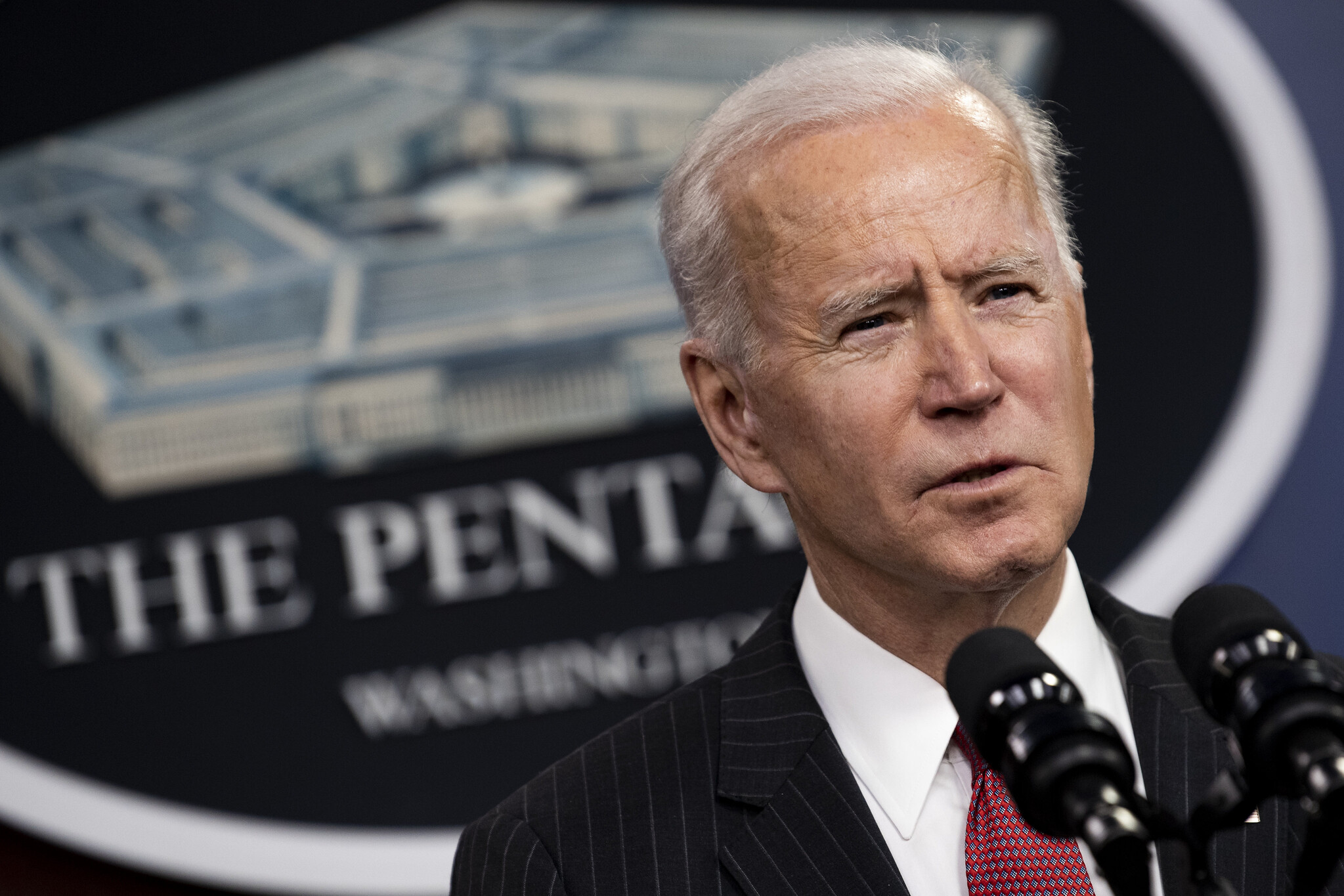Sadly, but all too predictably, Biden’s decision to withdraw U.S. troops and contractors from Afghanistan hasn’t generated even the slightest peace dividend, writes William D. Hartung.

U.S. President Joe Biden at the Department of Defense, Feb. 10, 2021. (DoD, Lisa Ferdinando)
By William D. Hartung
TomDispatch.com
 2021 was another banner year for the military-industrial complex, as Congress signed off on a near-record $778 billion in spending for the Pentagon and related work on nuclear warheads at the Department of Energy. That was $25 billion more than the Pentagon had even asked for.
2021 was another banner year for the military-industrial complex, as Congress signed off on a near-record $778 billion in spending for the Pentagon and related work on nuclear warheads at the Department of Energy. That was $25 billion more than the Pentagon had even asked for.
It can’t be emphasized enough just how many taxpayer dollars are now being showered on the Pentagon. That department’s astronomical budget adds up, for instance, to more than four times the cost of the most recent version of President Joe Biden’s Build Back Better plan, which sparked such horrified opposition from Sen. Joe Manchin (D-WV) and other alleged fiscal conservatives.
Naturally, they didn’t blink when it came to lavishing ever more taxpayer dollars on the military-industrial complex.
Opposing Build Back Better while throwing so much more money at the Pentagon marks the ultimate in budgetary and national-security hypocrisy. The Congressional Budget Office has determined that, if current trends continue, the Pentagon could receive a monumental $7.3 trillion-plus over the next decade, more than was spent during the peak decade of the Afghan and Iraq wars, when there were up to 190,000 American troops in those two countries alone.
Sadly, but all too predictably, Biden’s decision to withdraw U.S. troops and contractors from Afghanistan hasn’t generated even the slightest peace dividend. Instead, any savings from that war are already being plowed into programs to counter China, official Washington’s budget-justifying threat of choice (even if outshone for the moment by the crisis in Ukraine).
And all of this despite the fact that the United States already spends three times as much as China on its military.
The Pentagon budget is not only gargantuan, but replete with waste — from vast overcharges for spare parts to weapons that don’t work at unaffordable prices to forever wars with immense human and economic consequences. Simply put, the current level of Pentagon spending is irrational.
Price Gouging on Spare Parts

A. Ernest Fitzgerald, Pentagon whistleblower. (U.S. Air Force, Wikimedia Commons)
Overcharging the Pentagon for spare parts has a long and inglorious history, reaching its previous peak of public visibility during the presidency of Ronald Reagan in the 1980s.
Then, blanket media coverage of $640 toilet seats and $7,600 coffee makers sparked public outrage and a series of hearings on Capitol hill, strengthening the backbone of members of Congress. In those years, they did indeed curb at least the worst excesses of the Reagan military buildup.
Such pricing horror stories didn’t emerge from thin air. They came from the work of people like legendary Pentagon whistleblower Ernest Fitzgerald. He initially made his mark by exposing the Air Force’s efforts to hide billions in cost overruns on Lockheed’s massive C-5A transport plane. At the time, he was described by former Air Force Secretary Verne Orr as “the most hated man in the Air Force.”
Fitzgerald and other Pentagon insiders became sources for Dina Rasor, a young journalist who began drawing the attention of the media and congressional representatives to spare-parts overcharges and other military horrors. In the end, she formed an organization, the Project on Military Procurement, to investigate and expose waste, fraud, and abuse. It would later evolve into the Project on Government Oversight (POGO), the most effective current watchdog when it comes to Pentagon spending.
A recent POGO analysis, for instance, documented the malfeasance of TransDigm, a military parts supplier that the Department of Defense’s inspector general caught overcharging the Pentagon by as much as 3,800 percent — yes, you read that figure right! — on routine items. The company was able to do so only because, bizarrely enough, Pentagon buying rules prevent contract officers from getting accurate information on what any given item should cost or might cost the supplying company to produce it.
In other words, thanks to Pentagon regulations, those oversight officials are quite literally flying blind when it comes to cost control. The companies supplying the military take full advantage of that.
The Pentagon Inspector General’s office has, in fact, uncovered more than 100 overcharges by TransDigm alone, to the tune of $20.8 million. A comprehensive audit of all spare-parts suppliers would undoubtedly find billions of wasted dollars. And this, of course, spills over into ever more staggering costs for finished weapons systems. As Ernest Fitzgerald once said, a military aircraft is just a collection of “overpriced spare parts flying in formation.”
Not Needed & Not Affordable

An F-35 training simulator at Eglin Air Force Base, Florida. (Lockheed Martin)
The next level of Pentagon waste involves weapons we don’t need at prices we can’t afford, systems that, for staggering sums, fail to deliver on promises to enhance our safety and security. The poster child for such costly, dysfunctional systems is Lockheed-Martin’s F-35 combat aircraft, a plane tasked with multiple missions, none of which it does well.
The Pentagon is slated to buy more than 2,400 F-35s for the Air Force, Marines and Navy. The estimated lifetime cost for procuring and operating those planes, a mere $1.7 trillion, would make it the Pentagon’s most expensive weapons project ever.
Once upon a time (as in some fairy tale), the idea behind the creation of the F-35 was to build a plane that, in several variations, would be able to carry out many different tasks relatively cheaply, with potential savings generated by economies of scale.
Theoretically, that meant the bulk of the parts for the thousands of planes to be built would be the same for all of them. This approach has proven a dismal failure so far, so much so that the researchers at POGO are convinced the F-35 may never be fully ready for combat.
Its failures are too numerous to recount here, but a few examples should suffice to suggest why the program minimally needs to be scaled back in a major way, if not canceled completely.
For a start, though meant to provide air support for troops on the ground, it’s proved anything but well-designed to do so. In fact, that job is already handled far better and more cheaply by the existing A-10 “Warthog” attack aircraft.
A 2021 Pentagon assessment of the F-35 — and keep in mind that this is the Department of Defense, not some outside expert — found 800 unresolved defects in the plane. Typical of its never-ending problems: a wildly expensive and not particularly functional high-tech helmet which, at the cost of $400,000 each, is meant to give its pilot special awareness of what’s happening around and below the plane as well as to the horizon.
And don’t forget that the F-35 will be staggeringly expensive to maintain and already costs an impressive $38,000 an hour to fly.
In December 2020, House Armed Services Committee Chair Adam Smith finally claimed he was “tired of pouring money down the F-35 rathole.” Even former Air Force Chief of Staff General Charles Brown acknowledged that it couldn’t meet its original goal — to be a low-cost fighter — and would have to be supplemented with a less costly plane.
He compared it to a Ferrari, adding, “You don’t drive your Ferrari to work every day, you only drive it on Sundays.” It was a stunning admission, given the original claims that the F-35 would be the Air Force’s affordable, lightweight fighter and the ultimate workhorse for future air operations.

Secretary of Defense Lloyd Austin, right; Mark A. Milley, chairman of the Joint Chiefs of Staff, center; with Sen. Patrick Leahy before their testimony before the Senate Appropriations Committee regarding fiscal year 2022 budget for the Defense Department, June 17, 2021. (DoD, Chad J. McNeeley)
It’s no longer clear what the rationale even is for building more F-35s at a time when the Pentagon has grown obsessed with preparing for a potential war with China. After all, if that country is the concern (an exaggerated one, to be sure), it’s hard to imagine a scenario in which fighter planes would go into combat against Chinese aircraft, or be engaged in protecting American troops on the ground — not at a moment when the Pentagon is increasingly focused on long-range missiles, hypersonic weapons, and unpiloted vehicles as its China-focused weapons of choice.
When all else fails, the Pentagon’s fallback argument for the F-35 is the number of jobs it will create in states or districts of key members of Congress. As it happens, virtually any other investment of public funds would build back better with more jobs than F-35s would.
Treating weapons systems as jobs programs, however, has long helped pump up Pentagon spending way beyond what’s needed to provide an adequate defense of the United States and its allies.
And that plane is hardly alone in the ongoing history of Pentagon overspending. There are many other systems that similarly deserve to be thrown on the scrap heap of history, chief among them the Littoral Combat Ship (LCS), essentially an F-35 of the sea.
Similarly designed for multiple roles, it, too, has fallen far short in every imaginable respect. The Navy is now trying to gin up a new mission for the LCS, with little success.

Dec. 4, 2010: The littoral combat ship Fort Worth is launched into the Menominee River in Marinette, Wisconsin, during a christening ceremony for the navy’s third littoral combat ship. (U.S. Navy, courtesy of Lockheed)
This comes on top of buying outmoded aircraft carriers for up to $13 billion a pop and planning to spend more than a quarter of a trillion dollars on a new nuclear-armed missile, known as the Ground-Based Strategic Deterrent, or GBSD, made by Northrop Grumman.
Such land-based missiles are, according to former Secretary of Defense William Perry, “among the most dangerous weapons in the world,” because a president would have only minutes to decide whether to launch them on being warned of an enemy nuclear attack. In other words, a false alarm (of which there have been numerous examples during the nuclear age) could lead to a planetary nuclear conflagration.
The organization Global Zero has demonstrated convincingly that eliminating land-based missiles altogether, rather than building new ones, would make the United States and the rest of the world safer, with a small force of nuclear-armed submarines and bombers left to dissuade any nation from launching a nuclear war.
Eliminating ICBMs would be a salutary and cost-saving first step towards nuclear sanity, as former Pentagon analyst Daniel Ellsberg and other experts have made all too clear.
Cover-the-Globe Strategy
And yet, unbelievably enough, I haven’t even mentioned the greatest waste of all: this country’s “cover the globe” military strategy, including a planet-wide “footprint” of more than 750 military bases, more than 200,000 troops stationed overseas, huge and costly aircraft-carrier task forces eternally floating the seven seas, and a massive nuclear arsenal that could destroy life as we know it (with thousands of warheads to spare).

U.S. sailors on Feb. 2 in a gun shoot aboard amphibious assault ship USS Tripoli in the Pacific Ocean. (U.S. Navy, Maci Sternod)
You only need to look at the human and economic costs of America’s post-9/11 wars to grasp the utter folly of such a strategy. According to Brown University’s Costs of War Project, the conflicts waged by the United States in this century have cost $8 trillion and counting, with hundreds of thousands of civilian casualties, thousands of U.S. troops killed and hundreds of thousands more suffering from traumatic brain injuries and post-traumatic stress disorder. And for what?
In Iraq, the U.S. cleared the way for a sectarian regime that then helped create the conditions for ISIS to sweep in and conquer significant parts of the country, only to be repelled (but not thoroughly defeated) at great cost in lives and treasure. Meanwhile, in Afghanistan, after a conflict doomed as soon as it morphed into an exercise in nation-building and large-scale counterinsurgency, the Taliban is back in power. It’s hard to imagine a more ringing indictment of the policy of endless war.
Despite the U.S. withdrawal from Afghanistan, for which the Biden administration deserves considerable credit, spending on global counterterror operations remains at high levels, thanks to ongoing missions by Special Operations forces, repeated air strikes, ongoing military aid and training, and other kinds of involvement short of full-scale war.
Given the opportunity to rethink strategy as part of a “global force posture” review released late last year, the Biden administration opted for a remarkably status quo approach, insisting on maintaining substantial bases in the Middle East, while modestly boosting the U.S. troop presence in East Asia.
China, China, China
As anyone who’s followed the news knows, despite the immediate headlines about sending troops and planes to Eastern Europe and weapons to Ukraine, the dominant narrative for keeping the Pentagon budget at its current size remains China, China, China.
It matters little that the greatest challenges posed by Beijing are political and economic, not military. “Threat inflation” with respect to that country continues to be the Pentagon’s surest route to acquiring yet more resources and has been endlessly hyped in recent years by, among others, analysts and organizations with close ties to the arms industry and the Department of Defense.
For example, the National Defense Strategy Commission, a congressionally mandated body charged with critiquing the Pentagon’s official strategy document, drew more than half its members from individuals on the boards of arms-making corporations, working as consultants for the arms industry, or from think tanks heavily funded by just such contractors.
Not surprisingly, the commission called for a 3 percent to 5 percent annual increase in the Pentagon budget into the foreseeable future. Follow that blueprint and you’re talking $1 trillion annually by the middle of this decade, according to an analysis by Taxpayers for Common Sense.
Such an increase, in other words, would prove unsustainable in a country where so much else is needed, but that won’t stop Pentagon budget hawks from using it as their North Star.
In March of this year, the Pentagon is expected to release both its new national defense strategy and its budget for 2023. There are a few small glimmers of hope, like reports that the administration may abandon certain dangerous (and unnecessary) nuclear-weapons programs instituted by the Trump administration.
However, the true challenge, crafting a budget that addresses genuine security problems like public health and the climate crisis, would require fresh thinking and persistent public pressure to slash the Pentagon budget, while reducing the size of the military-industrial complex.
Without a significant change of course, 2022 will once again be a banner year for Lockheed Martin and other top weapons makers at the expense of investing in programs necessary to combat urgent challenges from pandemics to climate change to global inequality.
William D. Hartung, a TomDispatch regular, is a senior research fellow at the Quincy Institute for Responsible Statecraft and the author of Profits of War: Corporate Beneficiaries of the Post-9/11 Surge in Pentagon Spending” (Brown University’s The Costs of War Project and the Center for International Policy, September 2021).
This article is from TomDispatch.com.
The views expressed are solely those of the author and may or may not reflect those of Consortium News.

A rather responsibly well articulated presentation by Hartung, I should state, lamenting thereby the glaringly missing peace dividend even at the conclusion of the previous Cold War and since. Even in these current, I believe, post-Covid times humanity, not just in America, is poised to be robbed of the promised boon of the BBB, whatever THAT really meant to its perpetuators ! The American alleged ditching of the ICBMs and the GBSDs is wise and would be most welcomed by all disarmament advocates, for sure. But the same would not also be said of the prospective sidelining of the LCSs, for those are big ticket items viewed favourably especially in the regions still welcoming of an American presence, especially by their ruling elites for their theater-relevant roles. So, despite the EXORBITANT WASTAGES inherent in the MIC itself, it is important not to heavily defund it as suggested by some quarters but rather to reorient it towards meeting more legitimate defense needs such as the production of superior air defense systems, hypersonics, particularly SLCM ones, and yes defensively-configured UAVs. The resultant sure savings should be more fruitfully expanded on addressing various socio-ethnic and socio-economic inequalities, regional development, poverty-eradication and public welfare projects, both at home and in the welcoming abroad !
Sadly Mr. Hartung, you are largely correct. The good news/bad news is that we are doing to ourselves what we claimed we forced the old SovU to do – spend ourselves into penury. We are currently spending round about $1T a year on the military (The almost $800B official Department of War budget does not include black programs (secret), nuclear weapons programs (DoE), or VA programs (HHS). When the world decides to stop supporting us by not buying our debt, when countries cease to hold the US$ as part of their reserves because it’s losing value faster than ether in a petri dish, when oil is being paid for in national currencies and not the US dollar (see Russia, China, Iran, etc) and when our infrastructure finally bursts at the seams we’ll come to understand what Mr. Putin was talking about when he said it was a mistake to use our currency as a weapon.
Finland just decided to by 64 F35-planes. It is so sad that our politicians and generals have become the useful idiots for Pentagon`s war machine.
I stumbled on this video that I didn’t remember from 1991 called “Voices That Care” a David Foster song with many celebrities to boost the morale of troops in something called “Operation Desert Storm” a Persian Gulf War, and it’s so weird that the idea of war in a foreign land, an illegal unjustified corrupt stupid war, seems to bring people together. We never seem to learn anything, and now they’re sending troops to fight a war for Ukrainians! This is so appalling, they got Ferrari style toys that they don’t even need, and we here at home get jack squat. hxxps://www.youtube.com/watch?v=KJ1S_UNaWps
“Meanwhile, in Afghanistan, after a conflict doomed as soon as it morphed into an exercise in nation-building and large-scale counterinsurgency, the Taliban is now in power.
Correction: back in power
This was predictable the moment we allied with the warlords, people so bad that the populace see the Taliban as preferable. If you look at it from the point of view of the populace it’s understandable. Their daughters may not be able to go to school now and may have to wear a burka, but at least they aren’t available to be raped, kidnapped, and/or killed by any of the warlord’s lackeys.
Veterans For Peace has just launched a new initiative that you can find here: veteransforpeace/war-industry-resisters-network. There are monthly Zoom meetings to plan major actions for tax week. Please get involved.
The money printing presses must be running red hot from overuse .Mind you they are just numbers , digits if you will and nothing to worry about because nobody is paying much attention anyway . A million here and billion there ,first thing you know it adds up to some serious moulah .Wall Street is still humming so ,nothing to see here ,Russia ,China and Ukraine is where it happening !